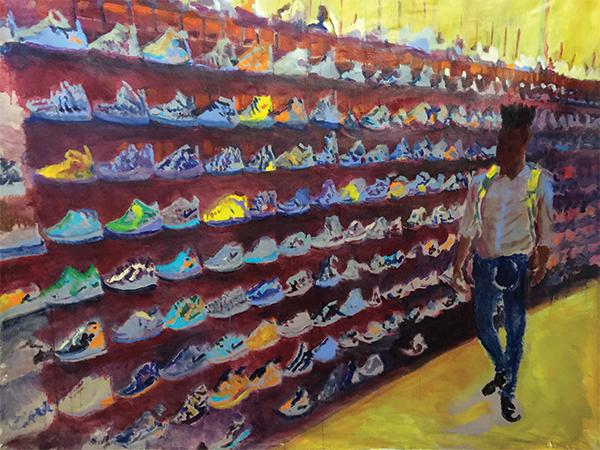MUSEUM EXHIBITION
The Sun Valley Center for the Arts invited artist Conrad Bakker to participate in a residency at The Center, Hailey, and respond to the economies of the Wood River Valley. Drawn to the area’s history as a place for mining as well as mountain recreation, Bakker collected nearly 100 Idaho rocks that he then recreated as small sculptures. Each rock will be oICK fered for sale as part of a larger installation, Untitled Project: Mountain Rock Shop. Visitors are invited to purchase a rock that they’ll be able to collect at the conclusion of the exhibition. Bakker’s Mountain Rock Shop also exists as an online marketplace: www.untitledprojects.com/mountainrockshop.
Chad Erpelding marries data visualization and geometric abstraction in paintings that investigate global institutions. Marketplaces includes work from two projects that use color and pattern to represent trends in stock indices. One explores the impact of the 2016 vote in favor of Brexit on financial markets around the world. The other looks at the value of the major U.S. stock indices, from the low point of the 2008 recession to the high point of the economic recovery. Erpelding’s projects consider the way we buy and sell pieces of corporations, the interconnectedness of global economies, and the effects of political and social events on the economic lives of individuals.
Through most of the 1990s, American painter Brendan O’Connell lived and worked in Europe. Upon his return to the U.S., he was struck by how significantly American society had changed—particularly the way Ameri-cans now shopped. Walmart had dramatically expanded its chain of stores, fundamentally altering Americans’ relationship with retail. O’Connell began visiting Walmart stores across the country, capturing the architecture, shop-pers and brands he encountered along the way and creating a portrait of American consumption in the 21st century.
Brittany Powell Parich’s project Checkout includes approximately life-size sculptures of every item in one checkout lane of her local Fred Meyer store on one day in the summer of 2018. The sculptures’ bright colors and eye-catching logos are testament to the temptations of the grocery store checkout line, where carefully arranged displays of everything from candy and cough drops to beef jerky and Bic lighters beckon to shoppers. Powell Parich’s Checkout even includes summer 2018 issues of popular magazines like People and Better Homes & Gardens, a kind of grocery store time capsule.
The works in Mark R. Smith’s project The Silk Road investigate the history of commerce and trade along the historic Silk Road, which linked Asia to the Mediterranean, and on the online black market of the same name, which was a notorious site for the sale of illicit goods from 2011 to 2013. Smith’s large geometric works recall both textile patterns and computer circuitry. Smaller works feature images of real items he found for sale on the Silk Road website, from antiquities to construction equipment and drug paraphernalia. Smith invites viewers to consider the ways commerce has changed over time, from open-air bazaars to online market-places, but his project also underlines the fact that goods and services have circulated across vast geographical areas for centuries.
